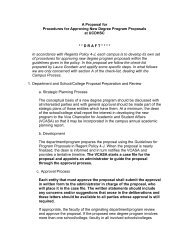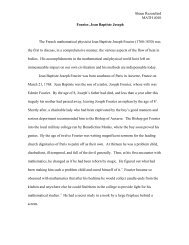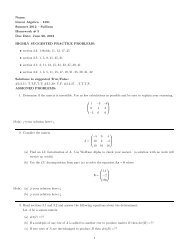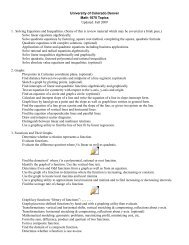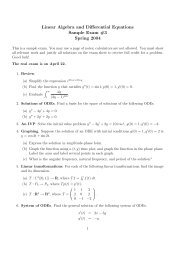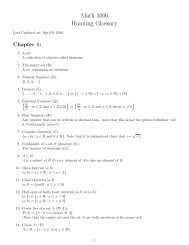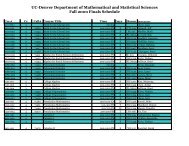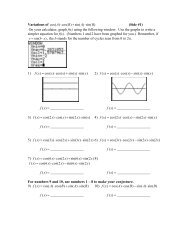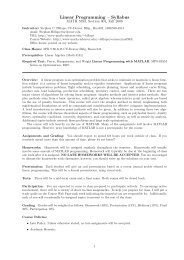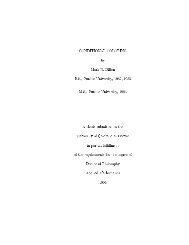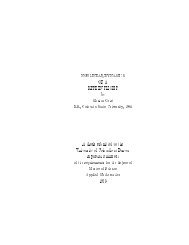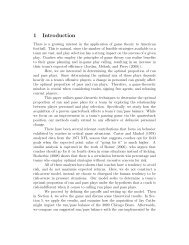Deriving Uniform Polyhedra Wythoff's Construction
Deriving Uniform Polyhedra Wythoff's Construction
Deriving Uniform Polyhedra Wythoff's Construction
You also want an ePaper? Increase the reach of your titles
YUMPU automatically turns print PDFs into web optimized ePapers that Google loves.
<strong>Deriving</strong> <strong>Uniform</strong> <strong>Polyhedra</strong><br />
with<br />
Wythoff’s <strong>Construction</strong><br />
Don Romano<br />
UCD Discrete Math Seminar<br />
30 August 2010
Outline of this talk<br />
• Fundamentals of uniform polyhedra<br />
– Definitions and properties<br />
– Convex solids<br />
– Regular polyhedra<br />
– Nonconvex solids<br />
– Early research<br />
• Systematic approach for deriving uniform polyhedra<br />
– Spherical tessellations<br />
– Wythoff‘s <strong>Construction</strong><br />
– The complete enumeration
Definitions and a few properties<br />
Def. A polyhedron is a finite set of polygons such that every side of<br />
each belongs to just one other, with the restriction that no subset<br />
has the same property<br />
Def. A uniform polyhedron is made up of regular polygons and its<br />
vertices are transitive<br />
– Vertex transitivity means there is an isometry (rotation, reflection)<br />
that takes any vertex to any other<br />
– All vertices are congruent and lie on a sphere<br />
There are 75 uniform polyhedra<br />
– 18 convex, 57 nonconvex and an infinite set of prismatoids
Exhibit at London Museum of Science
Budzelaar Collection
Pawlikowski Collection
Convex <strong>Uniform</strong> <strong>Polyhedra</strong><br />
• 5 Platonic Solids<br />
– Faces are regular polygons of only one kind<br />
– Symmetry groups form basis for all uniform<br />
polyhedra<br />
• Tetrahedral, Octahedral, Icosahedral<br />
– Known since antiquity — Euclid‘s Elements<br />
• 13 Archimedean Solids<br />
– Faces can be of more than one kind (2 or 3)<br />
– Can be derived from Platonics by simple<br />
operations of truncation, rectification, and<br />
cantellation<br />
– Two enantiomorphic pairs (snubs)<br />
– First enumeration by J. Kepler (ca. 1600)<br />
• 2 infinite sets of convex prisms and antiprisms<br />
– Dihedral symmetry
Platonic and Archimedean Solids
Regular <strong>Polyhedra</strong><br />
Def. A regular polyhedron is made up of only one kind of regular polygon<br />
and vertices are congruent<br />
– The 5 Platonic solids are regular<br />
– 4 Kepler-Poinsot solids are regular and nonconvex<br />
• 2 have star faces, 2 have star vertices<br />
• Derived by stellating or faceting Platonics<br />
“Wayside shrines at<br />
which one should<br />
worship on the way<br />
to higher things”<br />
– Peter McMullen
Nonconvex <strong>Uniform</strong> <strong>Polyhedra</strong><br />
• Can be derived by faceting Archimedean solids<br />
– Star polygons can be inscribed in faces<br />
– Removing one kind of polygon face and inserting others<br />
• Isomeghethic: same edge set<br />
• Many uniform polyhedra discovered between 1878 -1881<br />
– Edmund Hess (2)<br />
– Johann Pitsch (18)<br />
– Albert Badoureau (37)<br />
• Max Brückner<br />
– Vielecke und Vielflache (1900)<br />
• Isogonal-isohedra a.k.a. ‗noble‘ polyhedra
Brückner’s Noble <strong>Polyhedra</strong><br />
and many more . . .
Spherical Tessellations<br />
• Spherical triangles are bounded by<br />
segments of great circles<br />
• The sum of the angles of a spherical<br />
triangle are greater than 180 and less<br />
than 540<br />
• Area of spherical triangle<br />
A = r² E, where E is the spherical<br />
excess, that is, the sum of the angles<br />
minus 180<br />
• Only four ways to cover the sphere<br />
(once) with congruent spherical<br />
triangles
Möbius Triangles<br />
Let the angles of a spherical triangle be<br />
π/p, π/q, π/r where p, q, r are integers<br />
The area of the spherical triangle<br />
[(1/p + 1/q + 1/r) -1] π must be positive<br />
Hence, 1/p + 1/q + 1/r > 1.<br />
Only possibilities for p, q, r are 2, 3, 4, 5 with the restriction<br />
that 4 and 5 cannot occur together<br />
These lead to the four fundamental spherical triangles which are<br />
known as Möbius Triangles:<br />
(2,3 3), (2,3,4), (2,3,5), (2,2,r)<br />
Repeated reflections in sides of triangles will tile a sphere exactly once
The Four Fundamental Spherical Tilings<br />
(2,3 3) (2,3,4)<br />
(2,3,5) (2,2,r)
Tetrahedral Symmetry |g| = 24
Octahedral Symmetry |g| = 48
Icosahedral Symmetry |g| = 120
Dihedral Symmetry |g| = 4n
Schwarz Triangles<br />
Karl Schwarz (1873)<br />
• Proposed and solved problem of finding all spherical<br />
triangles which lead, by repeated reflections in their<br />
sides, to a set of congruent triangles covering the<br />
sphere a finite number of times<br />
• Extension of Möbius triangles where p, q, r are<br />
rational, but not necessarily integral<br />
Still have 1/p + 1/q + 1/r > 1 (positive area)<br />
Admissible values for p, q, r are 2, 3, 3/2, 4, 4/3, 5, 5/2, 5/3, 5/4 with<br />
restriction that numerators 4 and 5 cannot occur together<br />
– Some triplets are reducible<br />
– Some do not cover the sphere a finite number of times<br />
• 44 distinct Schwarz triangles and 2 others of infinite variety<br />
• The density, d, of a Schwarz triangle is the number of times sphere<br />
is covered
Schwarz triangles are composed of fundamental Möbius triangles<br />
π/5<br />
π/5<br />
π/5<br />
π/2<br />
Schwarz triangle (5/2 2 5)<br />
density = 3<br />
π/3<br />
π/5<br />
π/5<br />
Schwarz triangle (5/2 2 3)<br />
density = 7<br />
π/2
Schwarz Triangles — examples<br />
(2, 3, 5)<br />
Angles are π/2, π/3, π/5<br />
d = 1<br />
(3, 5, 5/3)<br />
Angles are π/3, π/5, 3π/5<br />
d = 4
Complete list of<br />
Schwarz triangles<br />
sorted by density<br />
Symmetry Groups<br />
5 Tetrahedral<br />
7 Octahedral<br />
32 Icosahedral<br />
2 Dihedral<br />
Density Schwarz triangle<br />
1 (2 3 3), (2 3 4), (2 3 5), (2 2 n)<br />
d (2 2 n/d)<br />
2 (3/2 3 3), (3/2 4 4), (3/2 5 5), (5/2 3 3)<br />
3 (2 3/2 3), (2 5/2 5)<br />
4 (3 4/3 4), (3 5/3 5)<br />
5 (2 3/2 3/2), (2 3/2 4)<br />
6 (3/2 3/2 3/2), (5/2 5/2 5/2), (3/2 3 5), (5/4 5 5)<br />
7 (2 3 4/3), (2 3 5/2)<br />
8 (3/2 5/2 5)<br />
9 (2 5/3 5)<br />
10 (3 5/3 5/2), (3 5/4 5)<br />
11 (2 3/2 4/3), (2 3/2 5)<br />
13 (2 3 5/3)<br />
14 (3/2 4/3 4/3), (3/2 5/2 5/2), (3 3 5/4)<br />
16 (3 5/4 5/2)<br />
17 (2 3/2 5/2)<br />
18 (3/2 3 5/3), (5/3 5/3 5/2)<br />
19 (2 3 5/4)<br />
21 (2 5/4 5/2)<br />
22 (3/2 3/2 5/2)<br />
23 (2 3/2 5/3)<br />
26 (3/2 5/3 5/3)<br />
27 (2 5/4 5/3)<br />
29 (2 3/2 5/4)<br />
32 (3/2 5/4 5/3)<br />
34 (3/2 3/2 5/4)<br />
38 (3/2 5/4 5/4)<br />
42 (5/4 5/4 5/4)
Wythoff’s <strong>Construction</strong><br />
Kaleidoscopic construction by tiling the<br />
sphere with a Schwarz triangles along<br />
with a specific point in the triangle<br />
Willem Wythoff (1907) applied this<br />
method to 4-dimensional problems<br />
• A point is chosen in Schwarz triangle<br />
• Repeated reflections of triangles produce multiple instances of that<br />
point around sphere<br />
• If suitable points are chosen, they will generate the vertices of a<br />
uniform polyhedron
Wythoff — point placements<br />
Points can be chosen in four ways, each with its own Wythoff Symbol<br />
p | q r<br />
Point is at a vertex P of triangle PQR<br />
p q | r<br />
Point is on side of PQ such that it bisects the angle at R<br />
p q r |<br />
Point is at the incenter of triangle PQR (intersection of angle bisectors)<br />
| p q r<br />
Point is the Fermat point and alternating triangles are used
Vertex positions for<br />
polyhedron with Wythoff symbol<br />
2|3 5<br />
Polyhedron with Wythoff symbol<br />
2|3 5
Vertex positions for<br />
polyhedron with Wythoff symbol<br />
2 3|5<br />
Polyhedron with Wythoff symbol<br />
2 3|5
Vertex positions for<br />
polyhedron with Wythoff symbol<br />
2 3 5|<br />
Polyhedron with Wythoff symbol<br />
2 3 5|
The Fermat point<br />
Spherical triangles alternately black and white
Vertex positions for<br />
polyhedron with Wythoff symbol<br />
|2 3 5<br />
Polyhedron with Wythoff symbol<br />
|2 3 5
Wythoff Symbol<br />
p|qr<br />
• Quasi-regular (16 polyhedrons)<br />
• Vertex configuration {q, r, q, r, . . . q, r}<br />
– Regular if r = 2 or q = r<br />
pq|r<br />
• Semi-regular (33 polyhedrons)<br />
• Vertex configuration {p, 2r, q, 2r}<br />
pqr|<br />
• Even-faced (14 polyhedrons)<br />
• Vertex configuration {2p, 2q, 2r}<br />
|pqr<br />
• Snub (11 polyhedrons)<br />
• Vertex configuration {3, p, 3, q, 3, r}
Non-Wythoffian Polyhedron<br />
• Great Dirhombicosidodecahedron<br />
– Discovered by J.C.P. Miller<br />
– ‗Miller‘s Monster‘<br />
• Found by combining both<br />
enantiomorphs of |3 5/3 5/2<br />
• Only uniform polyhedron with 8<br />
faces surrounding each vertex<br />
• Largest number of faces (124) and<br />
edges (240)<br />
• Euler characteristic Χ = - 56<br />
• Has 60 diametral squares that can<br />
be considered snub faces<br />
• Existence indicated no general<br />
reason for restriction to triangles as<br />
snub faces<br />
Vertex figure
Enumeration and Proof of Completeness<br />
H.S.M. Coxeter, M. S. Longuet-Higgins, J.C.P Miller<br />
• “<strong>Uniform</strong> <strong>Polyhedra</strong>”, Philosophical Transactions of<br />
the Royal Society of London, 1954<br />
• Complete enumeration of the 75<br />
• Conjectured that list was complete<br />
S.P. Sopov<br />
• “Proof of the Completeness of the Enumeration of<br />
<strong>Uniform</strong> <strong>Polyhedra</strong>”, Ukrain. Geom. Sbornik, 1970<br />
J. Skilling<br />
• ―The Complete Set of <strong>Uniform</strong> <strong>Polyhedra</strong>‖,<br />
Philosophical Transactions of the Royal Society of<br />
London, 1975<br />
• Computer search examined all possible polygon<br />
configurations for the basic symmetry groups<br />
• ―Skilling‘s Figure‖ was found by relaxing definition of<br />
uniform polyhedron to allow more than two faces at<br />
an edge<br />
Donald Coxeter<br />
John Skilling
Skillings Figure
Facial Intersections (Think inside the box!)<br />
| 3/2 3/2 5/2 {3} (1)<br />
<strong>Polyhedra</strong>l density = 38<br />
Individual surface segments = 3,000
Facial Intersections<br />
| 3/2 3/2 5/2 {3} (4)<br />
“Geometry is a skill of the eyes and<br />
hands as well as the mind.”<br />
- J. Pederson
Caution: Facial Intersections may be hazardous to your mental health!<br />
| 3/2 3/2 5/2 {5/2} (3)
A novice tackles<br />
Miller’s Monster<br />
(ca. 1973)
<strong>Uniform</strong> polytopes exist in higher dimensions!



